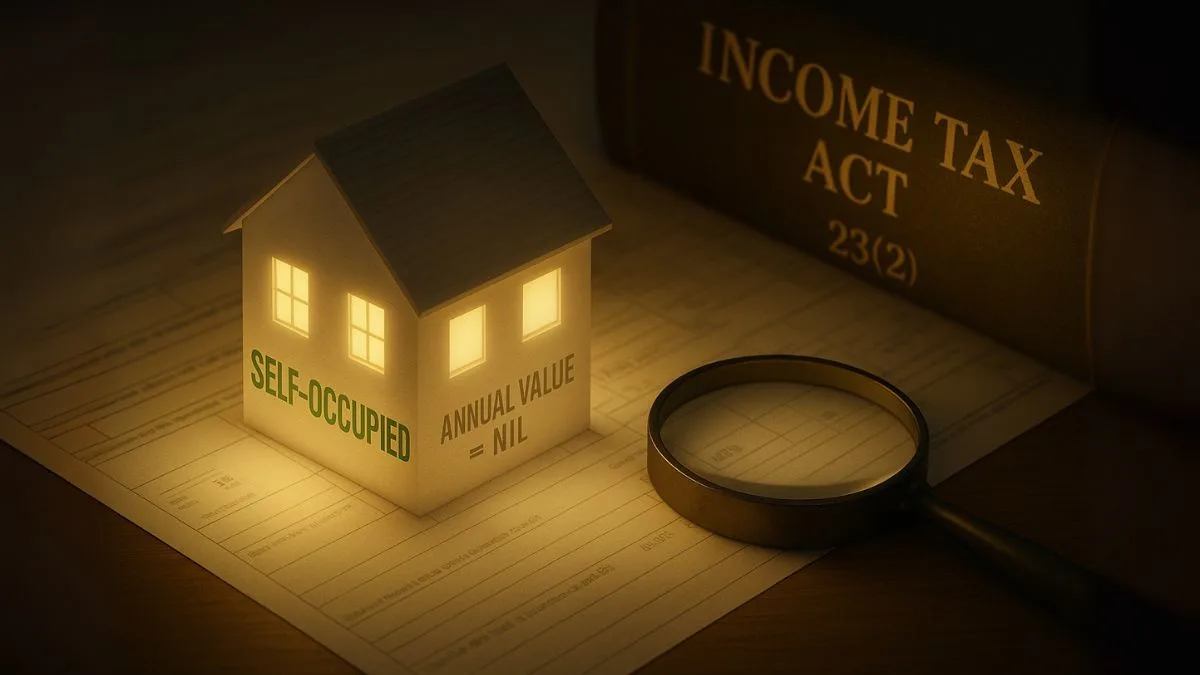
Owning a house is not just a matter of pride—it also has tax implications. Under Indian tax law, income from house property is a separate head of taxation, and its computation depends on whether the house is rented, deemed to be rented, or self-occupied. This is where Section 23(2) of the Income Tax Act comes into play.
This provision provides clarity on how to determine the annual value of a house that is used by the taxpayer for their own residence. It helps in avoiding unfair taxation on properties that do not generate rental income but are occupied by the owner.
What is Section 23 of the Income Tax Act?
Section 23 as a whole deals with the annual value of house property, which is the basis for calculating taxable income from that property. The law assumes that a house can generate rental income, & tax is levied accordingly.
However, this general rule does not apply to self-occupied properties. That’s why Section 23(2) was introduced—so homeowners are not taxed for living in their own house.
Section 23(2): Self-Occupied Property
According to Section 23(2) of the Income Tax Act, if a house property is self-occupied by the owner for residential purposes, the annual value is considered to be nil.
This means no notional rent or deemed income is calculated on the property. The taxpayer does not have to pay tax on an income that doesn’t actually exist.
This provision gives significant relief to homeowners, especially those with a single residence.
Also Read: House Property = Tax Liability? Understand Before You File
When You Own More Than One Property
While Section 23(2) provides full relief for one self-occupied house, complications arise when a taxpayer owns multiple properties.
- A taxpayer can choose any one house property as self-occupied, & its annual value will be taken as nil.
- The other property, even if not rented out, is treated as deemed to be let out, and a notional rental value is applied for taxation purposes."
This prevents misuse of the law while still protecting genuine taxpayers from unnecessary tax on their primary residence.
Conditions for Annual Value to be Nil
To claim the benefit of Section 23(2), the following conditions must be met:
- The house must be used for the taxpayer’s own residence.
- The property should not be let out during any part of the year.
- The taxpayer or their family must occupy it for residential purposes.
If these conditions are satisfied, the annual value is zero, & no tax is levied on that property.
Impact on Housing Loan Interest
Even though the annual value is nil, taxpayers can still claim deductions under Section 24(b) for interest on housing loans taken for purchase or construction of the self-occupied property.
- For self-occupied property, the maximum deduction allowed is ₹2,00,000 per year.
- Any interest exceeding this limit cannot be claimed.
This interaction between Section 23(2) and Section 24(b) plays a crucial role in tax planning for homeowners.
Example for Better Understanding
Let’s say Mr. Sharma owns two houses—one in Delhi where he lives & one in Jaipur which remains vacant.
- For the Delhi house: As it is self-occupied, under Section 23(2) its annual value is nil.
- For the Jaipur house: Even though it is vacant, it will be considered deemed to be let out, and a notional rent will be calculated for tax purposes."
This example shows how Section 23(2) balances tax relief with fairness in multiple property ownership cases.
Also Read: How ‘Actual Rent Received’ Affects Your Taxable Income
Importance of Section 23(2) for Taxpayers
Section 23(2) plays a key role in ensuring:
- Relief for homeowners – No tax on self-occupied property.
- Fair taxation – Prevents misuse by taxpayers owning multiple vacant houses."
- Support for middle-class taxpayers – Especially those who rely on housing loans.
By defining how annual value is determined, the section ensures fairness in the treatment of house property income.
Final Thoughts
Section 23(2) of Income Tax Act provides clarity & relief by exempting self-occupied property from notional taxation. It ensures that the annual value is taken as nil for one property used for residential purposes, while additional properties are treated as deemed let out. By linking with Section 24(b), it also supports housing loan deductions, striking a balance between tax fairness and taxpayer relief.
✅ Want to optimize your house property tax benefits under Section 23(2) and beyond? Visit Callmyca.com and let our experts help you save smartly while staying compliant.











